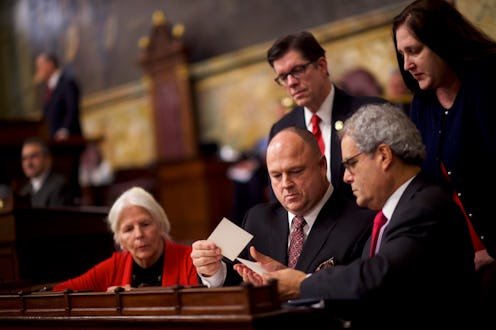News
Congress Can Object To The Electoral Vote Count
On Monday, the path to Donald Trump's inauguration seemed more certain than ever. Despite receiving a huge number of emails and calls from everyday citizens fearful of the incoming administration, the electors did not defect in high numbers. But there's still a way — again highly unlikely — that Trump could be kept out of the White House. It all comes down to Jan. 6 when Congress convenes to count the Electoral College votes. There, two members of Congress could object to the Electoral College vote. Thus what is a motion to withdraw from session? This is what happens after an objection.
According to the rules, for all or part of the Electoral College vote to be challenged, there must be an objection from both a senator and a representative — that is one member of each chamber. Then when that objection is lodged, the House and the Senate withdraw from their joint session and meet individually. The sessions are limited to two hours for each body, thus each senator and representative also faces a time limit of five minutes to speak.
Each body votes to uphold the objection (or more likely, not). If the objection is rejected, the Electoral College vote count is considered valid and all goes ahead normally. If it is upheld, and 270 electoral votes are not reached by any candidate, the selection of the president could move to the House, as the 12th Amendment dictates. They would then choose among the top three candidates with the most electoral votes for president. That would be Hillary Clinton, Colin Powell, and Trump. They would still probably elect Trump, but it would definitely be a disruption of great order.
This has only happened twice in our nation's history — and neither time did it affect the outcome of the election. The first time was in 1969, a tricky year for the Electoral College because there were three competitive candidates: Richard Nixon, Hubert Humphrey, and George Wallace, (who you might remember as the segregationist candidate who actually won several states in the South).
That year's counting of the electoral votes saw an objection to the vote of one North Carolina faithless elector. He was supposed to have voted Nixon but he voted Wallace instead, which prompted some in Congress to object, but ultimately his vote was counted when both the Senate and House rejected the objection.
The second and final time this occurred was in 2005 when George W. Bush beat John Kerry. A group of Democrats objected to Ohio's electoral votes being counted after there were allegations of irregularities there. The two separate bodies met to discuss the matter and the challenge was again defeated in both houses. The objection was rejected 267 to 31 in the House and 74 to 1 in the Senate. The Democrats said at the time their goal was not changing the results of the election but to bring attention to the need for election reform.
The odds that both the Republican House and Senate would keep Trump from the White House, or even delay it by entertaining objections is extremely unlikely. But this whole year has been a surprise so stay tuned. A few members of Congress might try to stop the Trump train before it gets out of the station.
